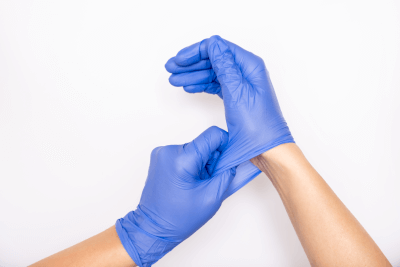What Is Nitrile Rubber?

Nitrile rubber (NBR) is a copolymer of acrylonitrile and butadiene. NBR’s oil and cold resistance vary by changing the composition of acrylonitrile and butadiene. With high nitrile NBR having high oil resistance and low nitrile NBR having excellent cold resistance.
Nitrile rubber is produced through the radical polymerization of acrylonitrile and butadiene, and its physical properties can be changed by adding a third monomer such as divinylbenzene.
Hydrogenated nitrile rubber, in which a portion of NBR is hydrogenated to improve ozone and weather resistance, is also available. For example, the higher the hydrogenation ratio, the higher the Mooney viscosity and solution viscosity.
Uses of Nitrile Rubber
Nitrile rubber (NBR) is a copolymer of acrylonitrile and butadiene. It is also used in disposable rubber gloves for handling organic solvents in laboratory work.
Nitrile rubber is made by increasing the acrylonitrile composition to increase oil resistance, and by increasing the butadiene composition to increase cold resistance. For example, high-nitrile NBR is used for parts in the petrochemical industry that require oil resistance, while low-nitrile NBR is used for parts that require cold resistance, such as aircraft parts and cold-weather gaskets.
Nitrile Rubber Manufacturing Process
Nitrile rubber is obtained by copolymerizing acrylonitrile and butadiene. NBR is obtained by radical polymerization, and peroxide is used as a polymerization initiator.
Nitrile rubber can easily change the monomer composition in rubber by changing the amount of acrylonitrile and butadiene monomers during polymerization. A third monomer can also be incorporated into NBR by adding it during polymerization. For example, NBR with improved extrudability by introducing divinylbenzene, which acts as a cross-linking agent, and NBR with improved strength by copolymerizing isoprene has been commercialized.
Hydrogenation of Nitrile Rubber
Nitrile rubber has double bonds in the molecule and is inferior in ozone and weather resistance. To overcome these disadvantages, hydrogenated nitrile rubber, in which the double bond is converted to a single bond by hydrogenating NBR, has been commercialized.
Note that since nitrile rubber also contains cyano groups, only the double bonds between the carbons in the main chain need to be selectively hydrogenated. For example, a metal catalyst such as palladium is used for the hydrogenation reaction. The physical properties of hydrogenated nitrile rubber depend on the ratio of hydrogenated double bonds. For example, the higher the hydrogenation ratio, the higher the Mooney viscosity and solution viscosity.